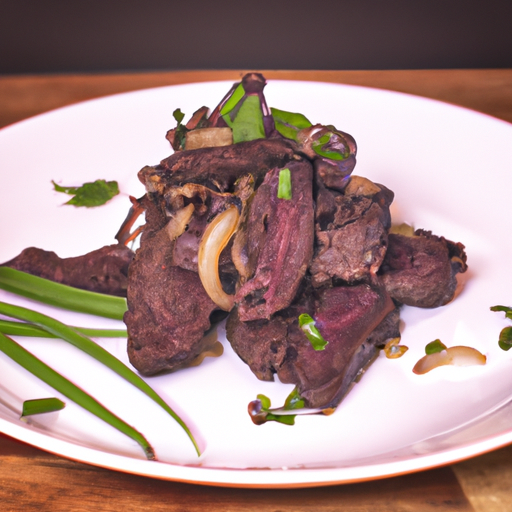Discover the fascinating world of Indigenous foods in Australia, as we take you on a culinary journey through the traditional flavors and culinary traditions of this diverse country. Prepare to be tantalized by the unique and diverse range of ingredients, cooking techniques, and cultural significance that make up the vibrant world of bush tucker. From the rich traditions of indigenous communities to the modern fusion dishes that celebrate native ingredients, this article will open your eyes to the richness of Australian food culture and leave you hungry for more. Get ready to savor the flavors of the land Down Under like never before!

History of Indigenous Food in Australia
Pre-contact Era
In Australia’s pre-contact era, Indigenous communities thrived on a rich food culture, relying on the abundance of natural resources that the land provided. Indigenous people were skilled hunters and gatherers, utilizing their profound knowledge of the land to source a diverse range of ingredients. The indigenous diet was primarily composed of bush tucker, which refers to the food obtained from the Australian bush.
Colonial Period
With the arrival of European colonizers, the Indigenous food culture faced significant challenges. The colonization process disrupted traditional hunting and gathering practices, as well as the connection to ancestral lands. Indigenous communities were forced to adapt to new agricultural practices and imported food items, causing a significant shift in their traditional diet.
Contemporary Indigenous Food Culture
Today, Indigenous food culture in Australia is experiencing a revitalization, as there is a growing movement towards preserving and celebrating traditional culinary practices. Many Indigenous communities are reclaiming their food heritage by incorporating bush tucker into their diets and showcasing their cuisine to the wider population.
Bush Tucker: Definition and Importance
What is Bush Tucker?
Bush tucker refers to the food traditionally consumed by the Indigenous people of Australia. It includes a wide variety of plants, animals, and insects, which were sourced sustainably from the land. Some common examples of bush tucker include kangaroo, emu, barramundi, witchetty grubs, and macadamia nuts. Bush tucker is deeply intertwined with Indigenous culture, serving as a source of sustenance, medicine, and connection to the land.
Significance of Bush Tucker in Indigenous Culture
Bush tucker holds immense cultural and spiritual significance for Indigenous Australians. It is not just a source of sustenance but also a way of reaffirming their identity and connection to their ancestral lands. The gathering and preparation of bush tucker often involve rituals, ceremonies, and the passing down of traditional knowledge from one generation to the next. Additionally, bush tucker is believed to possess medicinal properties, highlighting its importance as a form of indigenous medicine.

Traditional Indigenous Foods
Kangaroo
Kangaroo has been a staple in the Indigenous diet for thousands of years. It is a lean and highly nutritious source of protein, with a flavor profile that is often compared to beef. Kangaroo meat is versatile and can be cooked in various ways, such as grilling, roasting, or stewing. It continues to be cherished for its cultural and nutritional value, and many Indigenous communities are working towards promoting kangaroo as a sustainable and ethical alternative to other meats.
Emu
Emu is another widely consumed and revered traditional Indigenous food. Like kangaroo, emu meat is lean, low in fat, and high in protein. It has a rich, gamey flavor that is enjoyed in various dishes, including steaks, sausages, and even emu jerky. Emu eggs are also highly valued and are often used for ceremonial purposes.
Barramundi
Barramundi, a species of sea bass found in Australian waters, has been a significant food source for Indigenous communities in coastal regions. The fish is prized for its delicate, white flesh and mild flavor. Traditionally, barramundi was cooked over an open fire or in a bush oven, allowing the flavors to infuse with the surrounding scents of the Australian bush.
Witchetty Grub
The Witchetty Grub, the larval stage of several species of moths, is a unique and highly nutritious delicacy in Indigenous cuisine. It is considered a bush tucker icon due to its rich protein content and creamy texture. Witchetty grubs are often cooked in a variety of ways, including roasting, sautéing, or even eaten raw. Indigenous communities have revered the Witchetty Grub for centuries, acknowledging its cultural and spiritual significance.
Macadamia Nuts
Macadamia nuts, originating from the Australian rainforests, have long been an integral part of Indigenous diets. The nuts are nutrient-dense and provide a rich source of healthy fats. They are traditionally harvested by knocking them to the ground with sticks or gathering them after they have fallen naturally. Macadamia nuts are consumed raw or toasted and can be used in a wide range of sweet and savory recipes.
Traditional Indigenous Cooking Techniques
Pit Cooking
Pit cooking, also known as earth oven cooking, is a traditional method used by Indigenous Australians for thousands of years. It involves digging a pit in the ground, which is then lined with hot embers and stones. The food, such as meat, fish, or root vegetables, is placed on top of the hot stones and covered with leaves or bark, creating a natural steam oven. The food slowly cooks over the course of several hours, resulting in tender, moist, and flavorful dishes.
Hot Stone Cooking
Hot stone cooking is a technique where heated stones are used to cook food directly, without the need for additional cooking utensils. Stones are carefully selected and heated in a fire until they reach the desired temperature. The food, such as fish, meat, or even damper (traditional bread), is placed on the stones, allowing the heat to cook it through. The hot stones impart a unique smoky flavor to the food, enhancing its taste and texture.
Smoking
Smoking is a traditional Indigenous cooking technique utilized to preserve and flavor food. Fish, meat, or other ingredients are cured with salt and then hung over a fire, allowing the smoke to infuse the food. The smoke acts as a natural preservative, extending the shelf life of the food, while also adding a distinct smoky flavor.
Bush Oven
The bush oven, also referred to as a ground oven, is a method of cooking that involves using the heat from buried, smoldering embers to slowly roast food. The food, often wrapped in leaves or bark, is placed on top of the hot embers, and the hole is covered with soil to retain the heat. This technique results in succulent and flavorsome dishes, with the earthy aroma of the natural surroundings enhancing the experience.

Culinary Traditions across Different Indigenous Australian Regions
Culinary Traditions in Northern Australia
In the northern regions of Australia, Indigenous culinary traditions are heavily influenced by the abundance of tropical fruits, seafood, and bush tucker. The use of native spices, such as lemon myrtle and finger lime, adds a unique flavor profile to traditional dishes. Seafood, including barramundi, mud crabs, and shellfish, features prominently in the cuisine of this region.
Culinary Traditions in Central Australia
In the arid and semi-arid regions of central Australia, where water sources are scarce, Indigenous culinary traditions primarily focus on the usage of bush tucker that can withstand the harsh environment. Traditional ingredients such as bush tomatoes, quandongs, and desert raisins are used to create flavorful and nourishing dishes. Additionally, game meat like kangaroo and emu is widely utilized in central Australian Indigenous cuisine.
Culinary Traditions in Eastern Australia
Eastern Australia boasts diverse culinary traditions that are shaped by both coastal and inland influences. The region’s rich biodiversity provides an abundant supply of seafood, meats, and native plants. Indigenous communities in this region incorporate ingredients like sea succulents, oysters, yabbies, and river fish into their traditional dishes, creating a vibrant and flavorful culinary experience.
Culinary Traditions in Western Australia
The culinary traditions of Western Australia showcase a fusion of Indigenous and European influences. The coastal areas offer an abundance of seafood, including crayfish, prawns, and bream, which are featured in traditional dishes. Additionally, the region’s unique flora, such as wattleseed and saltbush, add depth and complexity to the cuisine, resulting in a truly distinctive culinary experience.
Cultural Significance of Indigenous Foods
Food as Medicine
Indigenous foods not only provide sustenance but are also considered to possess medicinal properties. Traditional Indigenous knowledge recognizes the specific healing qualities of various bush tucker ingredients. For example, the Kakadu plum is known for its high vitamin C content, providing a natural immune booster. Tapping into the medicinal potential of indigenous foods is an integral part of Indigenous culture, preserving both physical and spiritual well-being.
Ritual and Ceremony
Indigenous foods play a significant role in traditional rituals and ceremonies. The gathering, preparation, and sharing of bush tucker are often accompanied by songs, dances, and stories that reinforce cultural identity and spiritual beliefs. Food acts as a bridge between the physical and spiritual realms, facilitating a deeper connection with ancestors and the land.
Sustainable Food Practices
Indigenous food practices are rooted in a deep respect for the earth and its resources. Traditionally, Indigenous communities practiced sustainable hunting, fishing, and gathering techniques, ensuring the preservation of ecosystems for future generations. By promoting traditional food practices, Indigenous communities contribute to the broader movement towards sustainable and ethical food production.
Modern Adaptations and Fusion Cuisine
Indigenous Ingredients in Contemporary Australian Cuisine
In recent years, there has been a resurgence of interest in Indigenous ingredients within contemporary Australian cuisine. Renowned chefs and restaurants are incorporating native spices, fruits, and meats into their menus, creating unique and innovative dishes. This reimagining of traditional ingredients not only celebrates Indigenous culture but also showcases the incredible flavors and diversity of bush tucker to a wider audience.
Influence of Indigenous Foods on Non-Indigenous Australian Cuisine
Indigenous foods and traditional cooking techniques have significantly influenced non-Indigenous Australian cuisine. The incorporation of bush tucker ingredients, such as lemon myrtle or wattleseed, into mainstream cooking has added a distinctive Australian flavor to various dishes. This cross-pollination of culinary traditions promotes cultural diversity, fosters understanding, and highlights the importance of Indigenous food culture in shaping the broader Australian food scene.
Promotion and Celebration of Indigenous Foods
Indigenous Food Festivals
Indigenous food festivals provide a platform for showcasing traditional Indigenous foods, culinary traditions, and cultural practices. These festivals, such as the Tasting Australia Festival and the Melbourne Food and Wine Festival, offer an opportunity for Indigenous communities to share their food heritage with a wider audience. Visitors can indulge in traditional dishes, participate in cooking demonstrations, and learn about the cultural significance of Indigenous foods.
Inclusion in Fine Dining Restaurants and Menus
Fine dining restaurants and chefs across Australia are recognizing the value of Indigenous ingredients and culinary traditions. Many establishments now incorporate bush tucker into their menus, featuring dishes that blend traditional Indigenous ingredients with contemporary cooking techniques. This inclusion not only elevates Indigenous foods but also creates a unique dining experience that celebrates Australia’s rich cultural heritage.
Educational Programs and Workshops
Educational programs and workshops play a crucial role in promoting and preserving Indigenous food culture. Indigenous-led initiatives, such as cooking classes, bush tucker tours, and cultural workshops, provide opportunities for people to learn about traditional cooking techniques, the nutritional value of native ingredients, and the cultural significance of Indigenous foods. These educational experiences foster cross-cultural understanding and appreciation for Indigenous food traditions.
Preservation and Revitalization of Indigenous Food Culture
Efforts to Preserve Traditional Knowledge
Several organizations and Indigenous communities are working tirelessly to preserve and document traditional Indigenous food knowledge. By recording traditional recipes, gathering methods, and cooking techniques, this valuable knowledge can be passed down to future generations. This preservation ensures that Indigenous food culture remains alive and vibrant, preserving the connection between people, land, and food.
Community-led Initiatives
Indigenous communities are at the forefront of revitalizing and promoting their food culture. Through community-led initiatives, such as cultural centers, bush tucker gardens, and local food cooperatives, Indigenous people are reclaiming their food sovereignty. These initiatives empower communities to cultivate their traditional foods, create sustainable livelihoods, and strengthen cultural identity.
Importance of Passing Down Culinary Traditions
The passing down of culinary traditions is crucial for the preservation of Indigenous food culture. Elders and knowledge holders play a vital role in teaching younger generations about traditional gathering techniques, cooking methods, and the cultural significance of certain foods. By instilling pride and knowledge in younger community members, the continuity of Indigenous food culture is ensured for years to come.
Challenges and Opportunities for Indigenous Food Culture
Loss of Traditional Knowledge
The colonization process in Australia had a profound impact on Indigenous food culture. The forced assimilation, dispossession of lands, and disruption of cultural practices led to the loss of traditional knowledge surrounding Indigenous foods. Efforts are now being made to reclaim this knowledge and revitalize ancestral food practices through intergenerational sharing and community-led initiatives.
Access to Traditional Lands and Resources
Access to traditional lands and resources is a significant challenge faced by Indigenous communities. The encroachment of agricultural practices, mining, and urban development poses a threat to the availability of bush tucker ingredients. Efforts are being made to secure land rights and protect sacred sites, ensuring the ongoing availability and sustainability of Indigenous foods.
Commercialization vs. Cultural Integrity
As Indigenous foods gain popularity, there is a delicate balance between commercialization and preserving cultural integrity. It is essential to ensure that Indigenous communities are empowered and benefit economically from the growing demand for their foods. Moreover, respecting and involving Indigenous perspectives in the commercialization process is crucial to maintaining cultural authenticity and honoring the traditions behind Indigenous food culture.
In conclusion, Indigenous food culture in Australia is multifaceted and deeply rooted in the country’s history and landscape. Bush tucker, traditional ingredients, and cooking techniques have been revitalized and celebrated, contributing to the rich tapestry of Australian cuisine. The recognition and promotion of Indigenous foods not only provide economic opportunities but also foster a deeper appreciation and understanding of Indigenous culture. Through the preservation of traditional knowledge, community-led initiatives, and respectful collaboration, Indigenous food culture can thrive, ensuring its continued significance in the culinary landscape of Australia and beyond.

